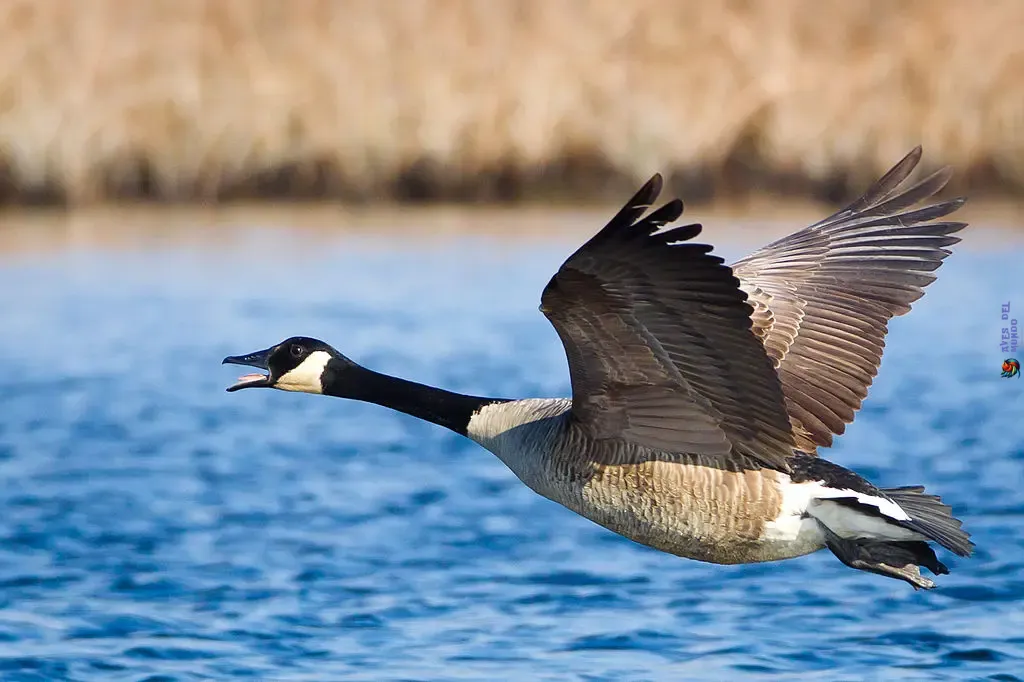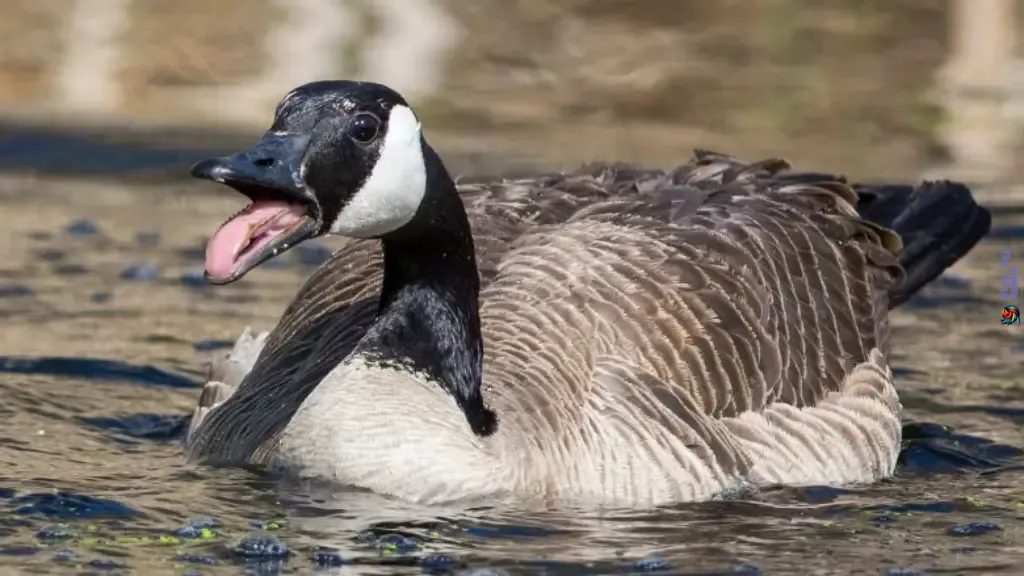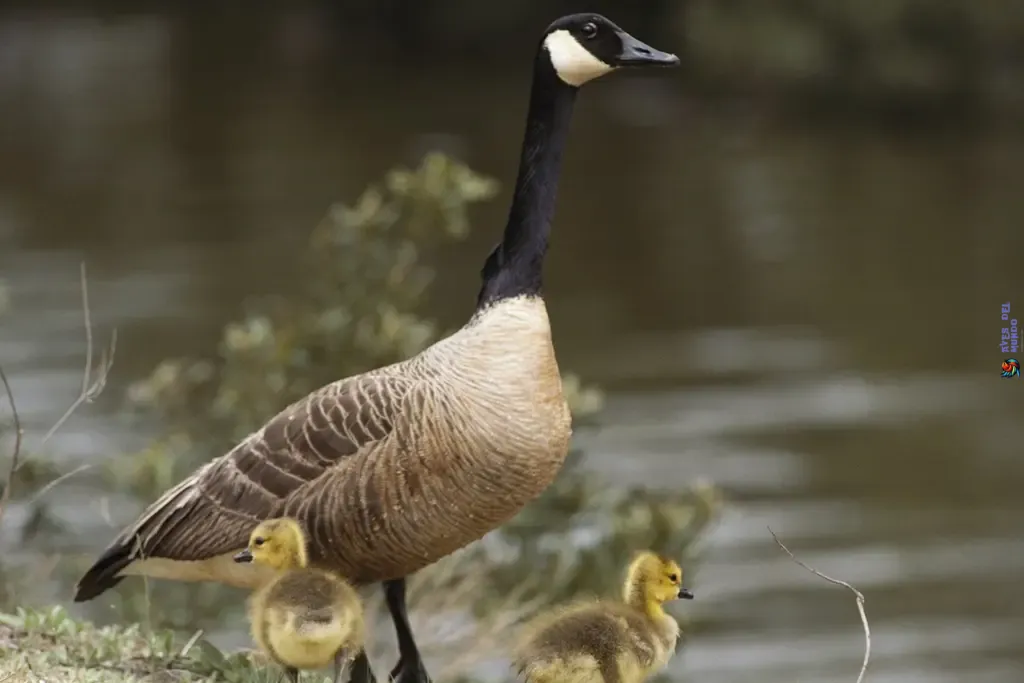Have you ever wondered how Canadian geese manage to embark on their remarkable annual journeys across vast distances? What drives these migratory birds to navigate through changing landscapes and endure challenging conditions? It’s time to uncover the hidden secrets behind the migration of Canadian geese and explore the fascinating world of these majestic creatures.

Canadian geese, also known as gansos canadienses, are one of the most iconic species of geese in Canada. They are renowned for their incredible long-distance migrations, which span thousands of kilometers. But what behaviors and habits enable these geese to accomplish such remarkable feats? What are the key factors that drive their migration patterns? And what can we learn from their journeys to aid in their conservation?
In this article, we will dive deep into the world of Canadian geese migration. We will uncover the secrets behind their exceptional navigation abilities, explore their flight formation and endurance, and shed light on the critical habitats and stopovers that play a vital role in their journey. Moreover, we will examine the ecological impact of their migration and the ongoing conservation efforts aimed at protecting these magnificent birds.
Get ready to embark on an extraordinary journey and discover the mysteries of Canadian geese migration. Let’s unveil the hidden secrets of these remarkable creatures and unlock a deeper understanding of their awe-inspiring annual migrations.



Unlocking the Mysteries of Canadian Geese Migration Patterns
Dive into the intricacies of Canadian geese migration patterns and gain insights into how these birds find their way during their annual journey. Canadian geese are known for their remarkable ability to navigate vast distances, and their migration patterns continue to captivate researchers and nature enthusiasts alike.
The Intricacies Behind Their Annual Journey
Every year, Canadian geese embark on a remarkable migration journey. They travel from their breeding grounds in Canada to their wintering grounds in warmer regions, covering thousands of miles. This awe-inspiring journey has fascinated scientists for decades, leading to numerous studies aimed at uncovering the secrets of their migration patterns.
Throughout their migration, Canadian geese display remarkable feat of endurance, navigating through various landscapes and overcoming potential obstacles along the way. Understanding the intricacies of their migration journey is essential for conservation efforts and appreciating the remarkable capabilities of these avian travelers.
How Geese Find Their Way: Nature’s Guidance Systems
One of the most intriguing aspects of Canadian geese migration is how they find their way across vast distances. These birds possess remarkable guidance systems that help them navigate with precision.
Research has shown that Canadian geese rely on a combination of environmental cues and innate instincts to navigate during their migration. These cues include the position of the sun, celestial landmarks, magnetic fields, and even landmarks on the Earth’s surface. By utilizing a combination of these cues, Canadian geese are able to maintain a consistent heading and reach their intended destinations.
Their nature-guided navigation systems demonstrate the remarkable adaptability and intelligence of these migratory birds. Understanding their navigation capabilities can provide valuable insights into the broader field of avian navigation and inspire advancements in technology and human navigation systems.
Revealing the Timing and Triggers of Migration
Another intriguing aspect of Canadian geese migration is the timing and triggers that prompt their annual journey. The timing of geese migration is influenced by various factors, including changes in temperature, food availability, and daylight hours.
As the days grow shorter and temperatures drop, Canadian geese receive biological signals that trigger their migration. These triggers prompt the geese to prepare for their journey and embark on their long flight to their wintering grounds. The timing of migration can vary slightly between different populations and regions, making it a fascinating area of study for researchers.
Studying the timing and triggers of geese migration not only enriches our understanding of these incredible birds but also helps us predict and manage their movements more effectively. This knowledge is crucial for conservation efforts and ensuring the well-being of Canadian geese populations.
Adapting to the Skies: The Formation and Flight of Canadian Geese
During their migratory journeys, Canadian geese showcase remarkable teamwork and adaptability in their formation and flight patterns. Flying in a characteristic V-shaped formation, these geese demonstrate a synchronized and efficient mode of travel, captivating both scientists and nature enthusiasts alike.
«Watching a flock of geese in flight is a truly awe-inspiring sight. Their coordinated movement and harmonious flight formation are a testament to their adaptability and collective intelligence.»
The advantage of flying in formation lies in the aerodynamic efficiency it provides. Each goose drafts off the one in front of it, benefiting from the upwash of air generated by the flapping wings. This reduces drag and expends less energy, enabling geese to conserve their strength for long-distance flights.
Additionally, the V-shaped formation allows geese to maintain clear lines of sight, facilitating communication and maintaining flock cohesion. The lead goose sets the pace, providing guidance for the rest of the flock. When the lead goose tires, it falls back into the flock, and another goose takes its place. This seamless rotational leadership ensures that geese share the responsibility of navigating the skies.
The migratory flight patterns of Canadian geese also serve as a visual representation of the adaptability of these birds. They can fly at altitudes ranging from 2,000 to 9,000 feet, adjusting their flight level based on the weather conditions and wind patterns they encounter. This ability to adapt to changing environmental factors is crucial for their survival and successful migration.
Furthermore, Canadian geese are known for their resilience even during adverse weather conditions. They have been observed flying in snowstorms, enduring strong headwinds, and navigating through fog without losing their way. Their ability to adapt and overcome these challenges is a testament to their species’ remarkable adaptation to life in the skies.
The formation and flight patterns of Canadian geese highlight the importance of cooperation and adaptability in the animal kingdom. By working together and adjusting their flight strategies, these birds maximize their energy efficiency and ensure their safe passage on their remarkable migratory journeys.
Insights Into the Canadian Geese’s Long-Distance Flight Endurance
Canadian geese are known for their remarkable long-distance flight endurance. To better understand this impressive ability, let’s delve into two key factors that contribute to their successful migration: diet and physiology.
Fueling for the Journey: The Diet of Migratory Geese
Proper nutrition is essential for Canadian geese to prepare for their arduous journey. These migratory birds have specific dietary requirements that support their energy needs during flight. Throughout their migration, geese consume a diverse diet consisting of:
- Aquatic vegetation: Canadian geese feed on various types of aquatic plants, such as pondweed and water lilies. These plants provide essential nutrients and fuel for their long flights.
- Grains and grasses: Geese also rely on agricultural crops like barley, wheat, and corn, as well as grasses found in fields and meadows. These food sources offer additional energy for sustained flight.
- Seeds and berries: As they traverse different habitats, geese opportunistically feed on seeds and berries, including those from sedges, grasses, and shrubs.
The migratory geese’s diverse diet allows them to adapt to varying food availability along their migration route, ensuring they have the necessary energy reserves for their extensive flights.
The Role of Physiology in Sustaining Flight
Geese possess unique physiological adaptations that enable them to sustain flight for extended periods. These adaptations include:
- Powerful wings: Canadian geese have strong pectoral muscles and large wingspans that generate the necessary lift and thrust for efficient flight.
- Aerodynamic body shape: Their streamlined bodies minimize air resistance, allowing geese to maintain higher speeds and conserve energy during flight.
- Efficient respiratory system: Geese have a highly efficient respiratory system that extracts a greater amount of oxygen from each breath, facilitating proper oxygenation of their muscles during long flights.
- Energy storage: Geese accumulate fat reserves before migration, which serve as an energy source during periods of limited food availability.
Combined, these physiological adaptations enable Canadian geese to undertake incredible feats of endurance, covering thousands of miles during their migration.
By understanding the diet and physiology of migratory geese, we gain valuable insights into the remarkable long-distance flight performance of these resilient birds.
The Habitats and Stopovers Critical to Canadian Geese
During their long and arduous migration journey, Canadian geese rely on specific habitats and critical stopovers for rest and replenishment. Understanding these resting havens and ensuring their preservation is crucial for the successful migration of these magnificent birds.
Mapping Out the Resting Havens of Geese En Route
Canadian geese follow well-established migration routes, stopping at various locations along the way to rest and refuel. These stopovers provide them with the necessary resources, such as food and water, to sustain their journey. Mapping out these resting havens is essential for conservation efforts and allows researchers to monitor the geese population and ensure the availability of suitable habitats along their migration path.
The Impact of Habitat Quality on Migration Success
The habitat quality plays a significant role in determining the success of Canadian geese migration. Suitable habitats provide the necessary food sources, open water bodies, and secure nesting grounds for these birds. Changes in habitat quality, such as habitat loss or degradation, can disrupt the geese’s migration patterns and affect their overall population. Therefore, ensuring the preservation and restoration of high-quality habitats is vital for the conservation of Canadian geese and the sustainability of their migration routes.
Canadian Geese: Family Bonds and Flock Dynamics During Migration
During their epic migration journey, Canadian geese showcase remarkable family bonds and flock dynamics. These migratory birds rely on their strong social structure to navigate and support each other throughout their arduous journey.
Their family bonds play a crucial role in their migration success. Canadian geese form tight-knit family units consisting of parents and their offspring. The parents, known as pairs, display remarkable coordination as they lead and guide their goslings on their long-distance flights.
Geese flock dynamics are also essential for their migration. These birds often fly in a characteristic V-formation, also called a chevron, which offers several benefits. The V-formation reduces individual birds’ air resistance, making flight more energy-efficient. It also allows geese to take turns leading the flock, relieving the burden on the front bird and ensuring all members contribute to navigation.
«We found that the V-formation provides aerodynamic advantages that save energy during flight,» says Dr. Jane Wilson, an avian behavior expert. «It’s fascinating to witness how geese seamlessly coordinate their movements within the flock to optimize their migration.»
Moreover, the social aspect of flying in a flock boosts overall group cohesion and communication among geese. They honk to stay connected while in flight, providing auditory cues that help maintain proper spacing within the group.
The combination of family bonds and flock dynamics allows Canadian geese to undertake their incredible migratory journeys with precision and efficiency. Through teamwork and cooperation, these birds demonstrate the power of social behavior in the world of migratory birds.

| Family Bonds and Flock Dynamics | Benefits |
|---|---|
| Tight-knit family units | Support and coordination during migration |
| V-Formation Flight | Aerodynamic advantages and energy efficiency |
| Communication and cohesion | Maintaining spacing and coordination within the flock |
The Evolutionary Tale of Canadian Geese’s Migration
Evolution of geese migration, historical trajectory of geese migration, evolving patterns of geese movement
From Past to Present: The Historical Trajectory of Geese Migration
Canadian geese have a long and storied history of migration that dates back thousands of years. The ancient ancestors of these migratory birds were already making incredible journeys across vast distances. Over time, the historical trajectory of geese migration has been shaped by various factors, including shifts in climate, changes in habitat availability, and adaptations in their behaviors.
By examining the past patterns of geese migration, researchers have uncovered valuable insights into how these birds have responded to environmental changes and adapted their movement strategies. The data collected from fossil records, ancient writings, and other historical sources provide a window into the evolving nature of geese migration over time.
One notable finding is that geese have shown remarkable resilience in navigating through different landscapes during their annual migration. Historical records illustrate how geese have utilized different flyways, or migration routes, to reach their seasonal habitats. These flyways are often influenced by geographical features such as coastlines, rivers, and mountain ranges, and they have shaped the paths taken by geese across generations.
As human civilization expanded and landscapes were altered, these migratory patterns have also been influenced. Urban development, pollution, and habitat destruction have posed challenges to geese migration routes. However, with conservation efforts and the preservation of critical habitats, there is hope for the continued success of geese migration.
Adaptation Over Generation: The Evolving Patterns of Movement
Geese migration is not solely a product of genetics, but also a result of adaptive behaviors passed down through generations. Through natural selection, geese that exhibited efficient and successful migration behaviors were more likely to survive and reproduce, leading to the evolution of certain patterns of movement.
Over time, geese have developed highly specialized physiological and navigational adaptations that enhance their migration capabilities. They rely on a combination of celestial cues, such as the position of the sun and stars, as well as environmental cues, such as landmarks and magnetic fields, to guide their journey. This complex guidance system has evolved to ensure their arrival at key stopover sites and nesting grounds.
The evolving patterns of geese movement also take into account changes in food availability and climate conditions. Geese have demonstrated the ability to adjust their migration routes and timing based on factors such as temperature, snow cover, and the availability of suitable feeding grounds. This adaptability allows them to optimize their chances of survival and successfully complete their migration.
Understanding the historical trajectory and evolving patterns of geese migration is crucial for conservation efforts and the preservation of these magnificent creatures. By studying the past and present behaviors of Canadian geese, we can gain insights into the challenges they face and develop strategies to protect their migration routes and habitats for generations to come.
The Scientific Methods Used to Uncover Geese Migration Secrets
Unraveling the mysteries of geese migration requires scientific methods and research techniques that allow scientists to delve into the intricate patterns and behaviors of these remarkable birds. By employing cutting-edge tools and technologies, researchers have made groundbreaking discoveries about the secrets behind Canadian geese migration.
Scientific methods for studying geese migration:
- Tracking technology: Scientists use GPS tracking devices attached to geese to monitor their movements and gather precise data on migration routes, stopovers, and duration of flights.
- Radio telemetry: Small radio transmitters are attached to geese, allowing scientists to track them in real-time and gather information about their behavior and habitat preferences.
- Geolocation and geospatial analysis: By analyzing geolocation data collected from satellites and ground-based stations, researchers can create detailed maps and models of geese migration patterns.
- Remote sensing: Scientists utilize satellite imagery and aerial surveys to study large-scale geese populations, assess habitat quality, and identify potential threats along migration routes.
- Genetic analysis: DNA sequencing and genetic markers are used to study the genetic diversity and population structure of geese, providing insights into their evolutionary history and migration patterns.
«Scientific methods and research techniques have opened new avenues of understanding geese migration, enabling us to uncover the secrets of their remarkable journeys. By combining technology, data analysis, and genetic research, we are gaining unprecedented insights into the behavior, physiology, and ecology of these migratory birds.»
| Research Techniques | Benefits |
|---|---|
| Tracking technology | Accurate mapping of migration routes and stopovers |
| Radio telemetry | Real-time monitoring of geese behavior and habitat preferences |
| Geolocation and geospatial analysis | Detailed understanding of migration patterns and habitat utilization |
| Remote sensing | Assessment of habitat quality and identification of threats |
| Genetic analysis | Insights into the evolutionary history and population dynamics of geese |
Thanks to these scientific methods and research techniques, we are continually expanding our knowledge of geese migration, unraveling their migration secrets, and ensuring the conservation of this remarkable natural phenomenon.
The Risks Faced by Canadian Geese During Migration
Gaining insights into the risks and challenges that Canadian geese encounter during their migration journey is essential for understanding their survival strategies. These migratory birds face numerous threats, including predation and hazards caused by human activities, which can impact their migration safety and overall population stability.
Surviving Natural Predators: Defense Mechanisms and Strategic Flying
Canadian geese have evolved several defense mechanisms to protect themselves from natural predators. One of their primary strategies is flying in large flocks, which increases their chances of detecting predators and evading attacks. The V-formation flight pattern, often associated with geese, provides aerodynamic advantages and allows them to conserve energy during long flights.
Additionally, geese exhibit vigilant behavior, with members of the flock taking turns acting as sentinels to watch for potential threats. They also utilize vocalizations and hissing sounds to communicate danger and establish dominance within the flock. These defense mechanisms help geese survive encounters with predators, such as foxes, coyotes, and birds of prey.
Human Impact: Navigating the Modern Threats to Migration Safety
While natural predators pose a threat to Canadian geese, human activities also contribute to the risks they face during migration. Human impact can disrupt their natural habitat, fragment migration routes, and introduce additional hazards to their journey.
Habitat loss due to urbanization, deforestation, and agricultural development can reduce available rest areas and food sources for geese during migration. Pollution, including water pollution and chemical contamination, can also negatively affect their overall health and fitness.
Furthermore, the increasing presence of man-made structures, such as buildings and power lines, poses collision risks for geese during flight. These obstacles can result in injury or death, affecting the migration safety and population dynamics of Canadian geese.
Understanding and mitigating these modern threats is crucial for safeguarding the well-being and conservation of Canadian geese populations.
Canadian Geese Migration and Its Ecological Impact
As Canadian geese embark on their annual migration, their journey has far-reaching implications for the ecosystems they traverse. The ecological impact of geese migration is profound, as these migratory birds contribute to the delicate balance of nature and play a crucial role in maintaining biodiversity.
During their migration, Canadian geese interact with various habitats, including wetlands, grasslands, and coastal areas. These diverse habitats provide crucial resources such as food, nesting sites, and resting areas for the geese and other species. The presence of geese in these ecosystems helps to disperse seeds and facilitate the growth of vegetation, promoting ecosystem health and resilience.
Additionally, the droppings of geese serve as natural fertilizers, enriching the nutrient content of the soil and supporting the growth of plants and aquatic organisms. This nutrient cycling process contributes to the overall productivity and vitality of the surrounding habitats.
The interconnectedness of ecosystems further magnifies the ecological impact of geese migration. As geese move from one habitat to another, they bring with them not only nutrients but also microorganisms and invertebrates, influencing the composition and dynamics of local populations. These interactions have a cascading effect on the entire food web, benefiting numerous species and enhancing the overall ecological balance.
The migration of Canadian geese is a remarkable phenomenon that highlights the intricate connections between migratory species and their habitats. By understanding and appreciating the ecological impact of geese migration, we can better comprehend the importance of conserving these birds and the ecosystems they depend on.
To visualize the ecological impact of geese migration, the table below highlights key findings from ecological studies:
| Ecological Impact of Geese Migration | Key Findings |
|---|---|
| Biodiversity | Geese migration helps maintain biodiversity by dispersing seeds, promoting vegetation growth, and enhancing food availability for other species. |
| Nutrient Cycling | Geese droppings serve as natural fertilizers, enriching the soil’s nutrient content and supporting the growth of plants and aquatic organisms. |
| Population Dynamics | The movement of geese influences the composition and dynamics of local populations, benefiting various species and contributing to the overall ecological balance. |
| Food Web Interactions | The presence of geese in different habitats influences the food web, providing resources for predators, scavengers, and decomposers. |
Through their migratory journey, Canadian geese establish vital connections between habitats and contribute to the functioning of ecosystems. Recognizing and protecting these connections is essential for the long-term conservation of geese populations and the preservation of the rich biodiversity they support.
Conservation Efforts to Protect the Canadian Geese and Their Migration Routes
Preserving the majestic Canadian geese and their crucial migration routes requires dedicated conservation efforts. Through wildlife management policies and grassroots movements, these measures aim to ensure the long-term survival of these remarkable migratory birds.
The Role of Wildlife Management and Policy in Preserving Species
Wildlife management plays a vital role in protecting Canadian geese and their migration routes. Through sustainable practices and habitat preservation, wildlife managers strive to create a conducive environment for geese to thrive. By monitoring and regulating hunting seasons, controlling invasive species, and managing land use, wildlife management policies aim to strike a delicate balance between human activities and the conservation of these magnificent creatures.
Grassroots Movements and Their Contributions to Geese Conservation
Grassroots movements form an essential part of the collective effort to protect Canadian geese and their migration routes. The passion and dedication of local communities, environmental organizations, and concerned individuals have led to the establishment of protected areas and the implementation of conservation projects. These grassroots initiatives involve habitat restoration, public education, and fostering community engagement. By raising awareness and encouraging responsible behaviors, these movements contribute significantly to the conservation of Canadian geese and the ecosystems they rely on.
Through the combined efforts of wildlife management policies and grassroots movements, we can create a sustainable future for Canadian geese. By protecting their habitats and ensuring safe migration routes, we can safeguard these iconic birds for generations to come.
